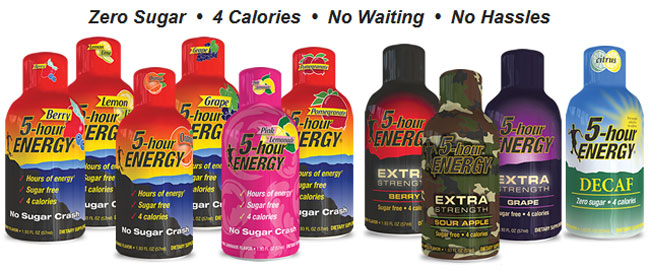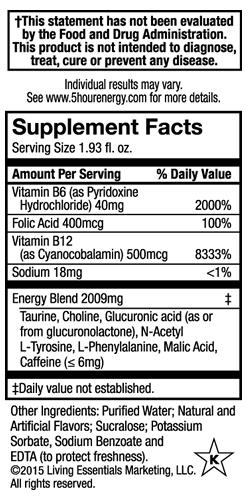5 Hour Energy Review
5 Hour Energy is one of the world’s most popular energy drinks. From college kids pulling all-nighters to long-haul truckers, people seem to love the 2 to 3 ounce shots of liquid energy provided by 5 Hour Energy.
What exactly is inside 5 Hour Energy?
Is it safe to drink?
Find out today in our 5 Hour Energy review.

What is 5 Hour Energy?
5 Hour Energy is a 2 to 3-ounce energy drink sold at convenience stores around the world. The energy drink was released in 2004 by a company called Living Essentials.
5 Hour Energy was the world’s first energy shot. Today, Living Essentials earns between $600 million and $1 billion per year in 5 Hour Energy revenue. Despite recent challenges from Red Bull, Monster Energy, and Coca-Cola, Living Essentials still holds a commanding share of the energy shot market.
5 Hour Energy has a few major advantages over other energy drinks. Many people appreciate the energy drink because it provides all of the “buzz” of other energy drinks without the huge amounts of sugar or calories. A key concept of 5 Hour Energy was creating an energy drink which contained just 2 to 3 ounces of liquid as opposed to the 12 to 16 ounce drinks created by Red Bull and others.
The energy drink isn’t famous for its taste: most users describe it as having a chalky, cough syrup-like taste.
5 Hour Energy Ingredients
A 2 ounce shot of 5 Hour Energy has just 4 calories. A regular 8 ounce can of Red Bull contains 100 calories.
Other beverages – like Rockstar and Monster – contain 280 calories in a standard-sized can. Even the sugar-free Red Bull contains 10 calories.
5 Hour Energy is also sugar-free, which is why it contains just 4 calories. An average Rockstar energy rink contains a whopping 67.5 grams of sugar, while standard-sized cans of Red Bull contain 11 grams of sugar.
When it comes to sugar and calories, 5 Hour Energy easily beats out the rest of the competition.
Here are all of the ingredients contained in a shot of 5 Hour Energy:
— Vitamin B6
— Vitamin B12
— Vitamin B3 (Niacin)
— Vitamin B9 (Folic Acid)
— Citicoline
— Tyrosine
— Phenylalanine
— Taurine
— Malic Acid
— Glucuronolactone
— Caffeine
Here’s what you see on the ingredients list when you buy a shot of 5 Hour Energy:

As you can see, 5 Hour Energy doesn’t list the specific amounts of all its ingredients. It hides its energy-boosting compounds inside its 2009mg “Energy Blend”, for example.
Of course, many people are concerned about the amount of caffeine in 5 Hour Energy. There are actually three types of 5 Hour Energy, and each of them has a different amount of caffeine:
— 5 Hour Energy Original Formula: 200mg
— 5 hour Energy Extra Strength Formula: 230mg
— 5 Hour Energy Decaf Formula: Less than 6mg
A small cup of coffee contains about 100mg of caffeine, so drinking a full shot of 5 Hour Energy is like having a large coffee or two smaller cups.
But it’s not just caffeine that gives 5 Hour Energy its boost: it’s also taurine. Taurine is an organic acid found in animal tissues. We get taurine naturally when we eat fish, meat, and dairy products. You have taurine in your system right now: it’s in your white blood cells, skeletal muscles, heart, and central nervous system.
Doctors will actually prescribe 2-3 grams of taurine to reduce the risk of congestive heart failure. When paired with caffeine, taurine works synergistically to boost mental and physical energy. It’s also thought to reduce the negative side effects of caffeine: like jitters and anxiety.
As you can see, 5 Hour Energy also has huge amounts of B vitamins: you get 2000% of your daily recommended dose of vitamin B6, for example, and 8333% of your daily recommended dose of vitamin B12.
Why does 5 Hour Energy include these ingredients? Vitamin B12 helps form red blood cells, while vitamin B6 boosts the immune system while also encouraging the production of red blood cells.
These vitamins are water-soluble and non-toxic: you can consume as many B vitamins as you want, but your body will simply urinate out any excess vitamins.
Vitamin B6 and B12 will actually boost your energy: but only if you’re currently deficient in B vitamins. Otherwise, they’re unlikely to have a huge effect on your system.
Side Effects of 5 Hour Energy
In the list of ingredients for 5 Hour Energy, the manufacturer lists a number of warnings for 5 Hour Energy. One of the most important warnings involves the fact that 5 Hour Energy contains an amino acid called phenylalanine.
Most people can naturally process phenylalanine without issue. But one out of every 15,000 people has a genetic disorder called phenylketonuria. This disorder means the body cannot break down the amino acid.
Phenylalanine is also found in aspartame. 5 Hour Energy’s manufacturers, however, are careful to note that there is no aspartame in 5 Hour Energy.
Interestingly enough, phenylketonuria is prevalent in both Turkey and Scotland – approximately 1 out of every 3,000 to 5,000 people suffers from the disorder.
Consuming too much caffeine per day has been linked to a number of side effects, including nervousness, difficulty sleeping, nausea, vomiting, rapid heartbeats, and high blood pressure.
If you just take a single shot of 5 Hour Energy per day, you are unlikely to experience any side effects – especially if you’re a regular coffee drinker. However, many people report experiencing more prominent side effects if they also drink a morning cup of coffee, an afternoon green tea, and other caffeinated beverages throughout the day.
About Living Essentials
5 Hour Energy is made by a company called Living Essentials. The company’s headquarters are located at 38955 Hills Tech Drive in Farmington Hills, Michigan.
The company is led by a mysterious figure named Manoj Bhargava. In 2012, Forbes.com called Bhargava “The Mystery Monk Making Billions With 5-Hour Energy.”
The company was founded in 2004. By 2012, it was earning $1 billion in retail sales. Since Living Essentials is a privately-held company, it doesn’t report its revenues or profits: although most estimates place retail sales between $600 million to $1 billion, with about $300 million net profit.
Industry analyst firm SymponhyIRI, which scans checkout scan data, claims that 5 Hour Energy holds a 90% stranglehold on the energy shot market.
Living Essentials, LLC, is owned by a parent firm called Innovation Ventures.
That same 2012 interview with Forbes.com was one of the first media interviews with Manoj Bhargava – which is why many view him as a mysterious figure. In that interview, Manoj said: “I’m probably the wealthiest Indian in America.”
In 2012, Manoj’s estimated net worth was $1.5 billion.
Why is he called a monk? For 12 years of his life, Bhargava traveled between monasteries owned and tended by an ashram called Hanslok. To this day, Bhargava claims he spends 1 hour in “contemplative silence” in his basement.
In any case, Manoj Bhargava appears to enjoy staying away from the spotlight. Since Living Essentials isn’t publically-traded, we know very little about the company. In addition, the names “Living Essentials” and “Innovation Ventures” were purposely chosen to be bland placeholder names: and then the names stuck.
Buying 5 Hour Energy
5 Hour Energy costs $3 per bottle and is available at convenience stores and grocery stores around the world.
You can find it at stores like GNC, Walgreens, Rite Aid, and many others in America.
One of the key marketing approaches of 5 Hour Energy is to place their products directly next to the till, guiding customers into making impulse purchases. That’s why you’ll typically see 5 Hour Energy next to the lighters, gum, and other small purchases at the front of the store.
You can also purchase 24-packs of 5 Hour Energy at Sam’s Club.
The official 5 Hour Energy Store can be found at Shop5HourEnergy.com. At the store, you can buy all different flavors of 5 Hour Energy and all three different formulas (Extra Strength, Decaf, and Original). If you’re a big fan of 5 Hour Energy, you can also buy 5 Hour Energy gear.
5 Hour Energy Flavors
As mentioned above, there are three different 5 Hour Energy flavors, including Original (200mg of caffeine), Extra Strength (230mg of caffeine), and Decaf (less than 6mg of caffeine).
Living Essentials periodically releases new flavors. Here are all the flavors currently available:
— Pink Lemonade
— Berry
— Lemon-Lime
— Orange
— Pomegranate
— Grape
Should You Use 5 Hour Energy?
5 Hour Energy is generally recommended to healthy adults who suffer from fatigue. It’s suggested as a short-term solution to temporary fatigue problems.
Those who drink coffee on a regular basis may find that 5 Hour Energy provides a stronger buzz: especially if your body is deficient in B vitamins. The addition of taurine can also make a noticeable difference.
In any case, 5 Hour Energy appears to be as safe to use as Starbucks coffees, Red Bulls, and other caffeinated beverages: provided you consume moderate amounts, you should be able to limit side effects while enjoying a positive energy boost.








